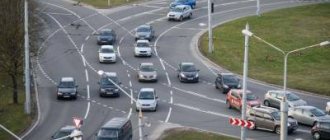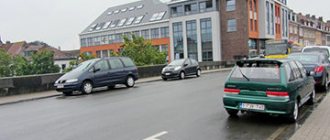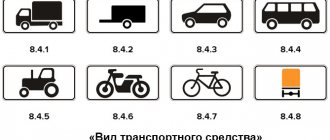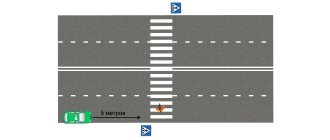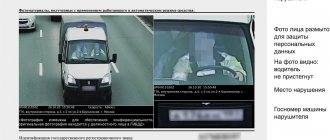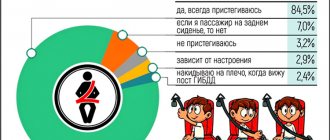What is a safety island and what are they?
According to the rules, a traffic island is a part of the road; it separates traffic lanes or, conversely, indicates their merging. Sometimes a traffic island is part of a pedestrian crossing. A pedestrian stops there to cross the road.
Islands are marked with markings and borders.
Island with markings. There are three options for marking an island using markings: to separate opposite lanes, separate and merge two streams of cars in one direction.
Island border. With its help, road services help pedestrians cross a multi-lane road.
Marking 1.16.1 separates opposite lanes. Source: rg.ru
Markup 1.16.2 separates traffic flows
Markup 1.16.3 merges two streams into one
Yellow posts stand on a hill with a curb - this is a safety island
Where is it prohibited and where is it allowed to park a car in 2021?
If the reason for the stop was forced measures or extreme necessity, for example, a car breakdown, driving to the markings is considered acceptable. At the same time, drivers very often complain that with the development of photo and video recording of traffic violations, they increasingly began to receive fines for repairing their car or waiting for help on such “islands.”
Since the Traffic Rules of the Russian Federation are a normative legal act, the norms specified in them are mandatory.
Special attention should be paid to horizontal markings (1.16.1, 1.16.2, 1.16.3.), which are applied to the road surface. They can be arranged:
- at unregulated and regular crossings;
- at an intersection where there is a roundabout;
- when entering populated areas (where there are frequent traffic jams).
Let’s immediately make a reservation that we will not consider raised islands, and especially transitions in places equipped with fencing. Few people would think of driving or parking there. Our further task is to deal with the islands, indicated only by markings.
Is it possible to avoid paying a fine for driving on an island?
It happens that the video recording camera made a mistake and incorrectly recorded a violation. This happens with Strelka-ST camera models. To give the driver a better chance of challenging the fine, it is better to use a DVR. Read about how to challenge fines from the State Traffic Safety Inspectorate, MADI or AMPP in our other article.
If the driver does not agree with the inspector’s decision, he can appeal it within 10 days. If the traffic police cancels the fine, you won’t have to pay.
In all other cases, this will have to be done, otherwise 70 days after the violation the fine will be handed over to the bailiffs. After this, the bailiffs will begin enforcement proceedings and assign an enforcement fee - 1000 rubles, or 7% of the fine. If you continue to not pay, the case will be taken to court and the money will be withdrawn from your bank account.
What to do if the case is already with the bailiffs or the money was withdrawn twice, read our analysis about the FSSP.
What it is?
A safety island is a part of the road surface on the carriageway with special traffic markings 1.16.1 - 1.16.3. The Russian Traffic Regulations say this:
According to the National Standard of the Russian Federation GOST R 52766-2007, the traffic island is located on the roadway or divided lane. At the same time, GOST states that:
- the distance between the roadway and the border of the island must be 7.5 m (clause 4.2.5.1);
- width - not less than the width of the pedestrian crossing, and length - from 1.5 m (clause 4.2.5.2)
A common unscientific argument against traffic islands is that drivers can run over them, causing the traffic island itself to cause accidents by reducing safety in the area. Indeed, an improperly designed and equipped island can cause accidents.
To minimize such cases, at all stages of the existence of a safety island (design, implementation and maintenance) it is important to ensure:
- correct design and implementation - for example, the island should have rounded edges, signs on it should not block the visibility of pedestrians and drivers;
- proper lighting - the island at the crossing should be visible to drivers, as well as pedestrians at the crossing;
- be properly marked – a crossing with a traffic island must be marked in accordance with government standards and traffic regulations;
- keeping signs in a clean condition , maintaining their visibility and reflective properties.
How to receive notifications on time to pay a fine at a discount
It happens that due to a large influx of visitors, electronic services work with malfunctions or a long delay. This was the case when the president signed a decree on child benefits in June 2021. Parents began to process payments through government resources and overloaded the server. There was no access to other services, such as checking fines, for a long time.
In order not to depend on force majeure, subscribe to the traffic police fines notifications. The service takes information directly from the GIS GMP database. All duties, fines and taxes in favor of the state pass through it.
What does it look like on the road and what is it used for?
In Appendix 2 to the traffic rules, the “safety island” is indicated by horizontal road markings 1.16.1 - 1.16.3, which are placed on the roadway in place. The purpose is as follows:
- 1.16.1 - serves to branch traffic flows;
- 1.16.2 - necessary for merging traffic flows;
- 1.16.3 - denotes islands at the confluence of traffic flows.
The following photo shows images of horizontal markings:
A safety island is marked by road markings in an area free from vehicle traffic and is intended for pedestrians to give them the opportunity to stop when crossing the roadway and not run across the road in front of oncoming vehicles.
On the road strip, the safety island is located in the form:
- area lined with curb stones above the roadway;
- zones designated by road markings;
- zones that are part of a pedestrian crossing;
- section of the dividing strip between traffic flows.
In Western Europe, buffer zones between traffic directions are mandatory on all streets with more than two lanes. With appropriate justification, when the width of the highway carriageway is 15 m or less, a traffic island with a width of at least 2 m can be constructed by narrowing the traffic lane to 3.25 m.
Islands can be developed:
- at an unregulated crossing;
- at a controlled crossing;
- at an intersection where there is a roundabout;
- at the entrance to populated areas.
How does a traffic island work?:
- Forces drivers to comply with the established speed limit due to the fact that it visually narrows the roadway at the pedestrian crossing and increases the concentration of drivers.
- Makes it impossible for a car to enter the oncoming lane to overtake or get ahead.
- Excludes parking and stopping at the crossing and in its immediate vicinity.
- Creates physical protection for pedestrians, a place where they can safely wait for vehicles to pass, and people can rest.
- They allow travel at speeds of 40-60 km/h, and therefore can be used painlessly on streets and roads with heavy traffic. This is an advantage over raised road elements (hill, raised crossing, etc.).
- At intersections, the turning radius is reduced and the driver is forced to slow down.
Remember
- A safety island is made by markings or by raising it above the road.
- The island is needed to separate traffic flows and protect pedestrians on the wide road.
- The fine for crossing or turning around on an island is 500 rubles.
- The fine for stopping or parking on an island is 1,000 rubles.
- If the fine is not paid within 70 days, the fine will be handed over to the bailiffs, who will write off the amount of the fine from the account.
- To receive notifications about fines on time and pay fines at a discount, subscribe to notifications on the Traffic Police Fines website.
Author: Evgeny Lesnov
Stopping (parking) on traffic islands, guide islands
Hello, dear readers! This article will discuss violations of traffic rules when stopping (parking) on traffic islands, guide islands, which drivers often use for purposes other than their intended purpose.
Let's turn to GOST R 52766-2007 to understand the definitions of “Guiding islands” and “Safety islands”.
GOST R 52766-2007 Public automobile roads. Arrangement elements. General requirements.
4.2.4 Guide islands
4.2.4.1 Guide islands are designed to separate traffic flows in directions at intersections of highways when the total traffic intensity on intersecting or adjacent roads is at least 1000 vehicles/day, when the number of turning vehicles is at least 10% of the total traffic flow on roads outside populated areas and not less than 20% in populated areas.
4.2.4.2 The boundaries of the guide islands are indicated by markings or by laying a curb, on which vertical markings are applied in accordance with GOST R 51256.
4.2.5 Traffic islands
4.2.5.1 When the vehicle traffic intensity is at least 400 units/hour per one lane of the roadway, at surface pedestrian crossings, safety islands are installed, which are placed on the roadway or dividing strip, and the distance between the edge of the roadway and the border of the island must be at least 7, 5 m.
4.2.5.3 The boundary of the traffic island is indicated by markings and/or curbs.
4.2.5.5 The center of the island on the roadway must be in line with the marking line separating traffic flows in opposite directions.
It is permissible to use the guide island as a safety island.
4.2.5.6 When placing an island on the roadway in front of it, a continuous inclined marking line 1.1 is applied on both sides.
Why do you need a traffic island?
Before moving on to other issues, let's clarify the parameters of traffic islands. First of all, let’s establish the difference between the internal markings according to paragraphs 1.16.1 – 1.16.3:
- 1.16.1 are straight parallel lines of different lengths. Used to designate islands separating flows of different directions.
- 1.16.2 – broken stripes, whose vertices are directed towards the convergence of flows. Used to designate islands when dividing a flow of one direction.
- 1.16.3 – also broken, but their vertices are opposite to the convergence of the flows. Denotes the merging of a one-way flow.
In most cases, traffic islands comply with paragraph 1.16.1. The rest are more often applicable to guide islands (which are not the topic of this article). However, there are exceptions, so we point out all types of possible markup.
Can a camera record this violation?
Overtaking, turning around, parking on a traffic island - all this can be recorded both by traffic police officers and with the help of cameras. Disputes often arise that the camera is not able to distinguish a stop from a parking lot, but in this case it does not matter - Part 3 (and therefore Part 6) of Article 12.19 of the Code of Administrative Offenses interprets sanctions for both types of this violation in the same way.
The problem may be due to a technical fault. It is not always possible to determine when the hazard warning lights are turned on in a photo. In this case, you will have to appeal the fine for leaving the traffic island.
Traffic rules requirements
The purpose of the solid line is that it separates traffic flows moving in different directions and marks the boundaries of traffic lanes in high-risk areas. This means that any maneuvers on this island are strictly prohibited and are equivalent to driving into the oncoming lane .
Within this island, traffic is allowed only for pedestrians, and nothing is said about the fact that this is strictly prohibited for drivers. Therefore, the traffic island cannot be considered a roadway . The rules stipulate that the movement of vehicles is possible only in the lanes designated for this purpose and there is no prohibition for traffic on this island.
If the driver is moving in the zone where the traffic island is located on the side of the solid line, then it is prohibited to cross this zone. This applies to white markings 1.16.1 – 1.16.3, which:
- separate traffic flows in the opposite direction;
- separate traffic flows in one direction;
- indicate the confluence of traffic flows.
